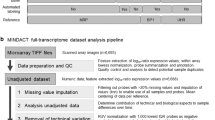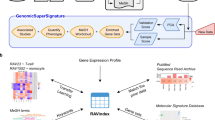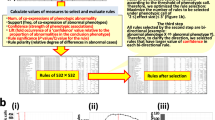Abstract
A problem in analyzing microarray-based gene expression data is the separation of genes causally involved in a disease from innocent bystander genes, whose expression levels have been secondarily altered by primary changes elsewhere. To investigate this issue systematically in the context of a class of complex human diseases, we have compared microarray-based gene expression data with non-microarray-based clinical and biological data about the schizophrenias to ask whether these two approaches prioritize the same genes. We find that genes whose expression changes are deemed to be of importance from microarrays are rarely those classified as of importance from clinical, in situ, molecular, single-nucleotide polymorphism (SNP) association, knockout and drug perturbation data. This disparity is not limited to the schizophrenias but characterizes other human disease data sets. It also extends to biological validation of microarray data in model organisms, in which genome-wide phenotypic data have been systematically compared with microarray data. In addition, different bioinformatic protocols applied to the same microarray data yield quite different gene sets and thus make clinical decisions less straightforward. We discuss how progress may be improved in the clinical area by the assignment of high-quality phenotypic values to each member of a microarray-assigned gene set.
This is a preview of subscription content, access via your institution
Access options
Subscribe to this journal
Receive 12 print issues and online access
$209.00 per year
only $17.42 per issue
Buy this article
- Purchase on Springer Link
- Instant access to full article PDF
Prices may be subject to local taxes which are calculated during checkout

Similar content being viewed by others
References
The Chipping Forecast II. Nature Genet. 32 (Suppl.), 465–552 (2002).
Taussig, M.J. & Landegren, U. Progress in antibody arrays. Targets 2, 169–176 (2003).
Ziauddin, J. & Sabatini, D.M. Microarrays of cells expressing defined cDNAs. Nature 411, 107–110 (2001).
Garber, K. Gene expression tests foretell breast cancer's future. Science 303, 1754–1755 (2004).
Holzman, T. & Kolker, E. Statistical analysis of global gene expression data: some practical considerations. Curr. Opin. Biotechnol. 15, 52–57 (2004).
Wigle, D., Tsao, M. & Jurisica, I. Making sense of lung-cancer gene-expression profiles. Genome Biol. 5, 309 (2004).
Andreasen, N.C., Arndt, S., Alliger, R., Miller, D. & Flaum, M. Symptoms of schizophrenia. Methods, meanings and mechanisms. Arch. Gen. Psychiatry 52, 341–351 (1995).
Andreasen, N.C. A unitary model of schizophrenia. Bleuler's “fragmented Phrene” as schizencephaly. Arch. Gen. Psychiatry 56, 781–787 (1999).
Sedvall, G. & Farde, L. Chemical brain anatomy in schizophrenia. Lancet 346, 743–749 (1995).
Harrison, P.J. The neuropathology of schizophrenia. A critical review of the data and their interpretation. Brain 122, 593–624 (1999).
McCarley, R.W. et al. MRI anatomy of schizophrenia. Biol. Psychiatry 45, 1099–1119 (1999).
Andreasen, N.C. Schizophrenia: the fundamental questions. Brain Res. Rev 31, 106–112 (2000).
Yolken, R.H., Karlsson, H., Yee, F., Johnston-Wilson, N.L. & Torrey, E.F. Endogenous retroviruses and schizophrenia. Brain Res. Rev. 31, 193–199 (2000).
Rothermundt, M., Arolt, V. & Bayer, T.A. Review of immunological and immunopathological findings in schizophrenia. Brain Behav. Immun. 15, 319–339 (2001).
Karlsson, H. et al. Retroviral RNA identified in the cerebrospinal fluids and brains of individuals with schizophrenia. Proc. Natl. Acad. Sci. USA 98, 4634–4639 (2001).
Freedman, R. Schizophrenia. N. Engl. J. Med. 349, 1738–1749 (2003).
Honey, G.D. et al. The functional neuroanatomy of schizophrenic subsyndromes. Psychol. Med. 33, 1007–1018 (2003).
Hakak, Y. et al. Genome-wide expression analysis reveals dysregulation of myelination-related genes in chronic schizophrenia. Proc. Natl. Acad. Sci. USA 98, 4746–4751 (2001).
Mirnics, K., Middleton, F.A., Marquez, A., Lewis, D.A. & Levitt, P. Molecular characterization of schizophrenia viewed by microarray analysis of gene expression in prefrontal cortex. Neuron 28, 53–67 (2000).
Vawter, M.P. et al. Application of cDNA microarrays to examine gene expression differences in schizophrenia. Brain Res. Bull. 55, 641–650 (2001).
Mimmack, M.L. et al. Gene expression analysis in schizophrenia: reproducible up-regulation of several members of the apolipoprotein L family located in a high-susceptibility locus for schizophrenia on chromosome 22. Proc. Natl. Acad. Sci. USA 99, 4680–4685 (2002).
Middleton, F.A., Mirnics, K., Pierri, J.N., Lewis, D.A. & Levitt, P. Gene expression profiling reveals alterations of specific metabolic pathways in schizophrenia. J. Neurosci. 22, 2718–2729 (2002).
Pongrac, J., Middleton, F.A., Lewis, D.A., Levitt, P. & Mirnics, K. Gene expression profiling with DNA microarrays: advancing our understanding of psychiatric disorders. Neurochem. Res. 27, 1049–1063 (2002).
Guidotti, A. et al. Decrease in reelin and glutamic acid decarboxylase 67 (GAD67) expression in schizophrenia and bipolar disorder. Arch. Gen. Psychiatry 57, 1061–1069 (2000).
Popken, G.J., Bunney, W.E., Potkin, S.G. & Jones, E.G. Subnucleus-specific loss of neurons in medial thalamus of schizophrenics. Proc. Natl. Acad. Sci. USA 97, 9276–9280 (2000).
Thompson, P.M. et al. Mapping adolescent brain change reveals dynamic wave of accelerated grey matter loss in very early-onset schizophrenia. Proc. Natl. Acad. Sci. USA 98, 11650–11655 (2001).
Rajkowska, G. & Goldman-Rakic, P.S. Cytoarchitectonic definition of prefrontal areas in the normal human cortex: II. Variability in locations of areas 9 and 46 and relationship to the Talairach coordinate system. Cereb. Cortex 5, 323–337 (1995).
Browning, M.D., Dudek, E.M., Rapier, J.L., Leonard, S. & Freedman, R. Significant reductions in synapsin but not synaptophysin specific activity in the brains of some schizophrenics. Biol. Psychiatry 34, 529–535 (1993).
McGinnis, R.E. et al. Failure to confirm NOTCH4 association with schizophrenia in a large population-based sample from Scotland. Nature Genet. 28, 128–129 (2001).
Volk, D.W., Austin, M.C., Pierri, J.N., Sampson, A.R. & Lewis, D.A. Decreased glutamic acid decarboxylase67 messenger RNA expression in a subset of prefrontal cortical γ-aminobutyric acid neurons in subjects with schizophrenia. Arch. Gen. Psychiatry 57, 237–245 (2000).
Bernstein, H.-G.C.A. et al. Hippocampal expression of the calcium sensor protein visinin-like protein-1 in schizophrenia. Neuroreport 13, 393–396 (2002).
Chudin, E. et al. Assessment of the relationship between signal intensities and transcript concentration for Affymetrix GeneChip arrays. Genome Biol. 3, research0005.1z–0005.10 (2001).
Churchill, G.A. Fundamentals of experimental design for cDNA microarrays. Nature Genet. 32 suppl. Suppl., 490–495 (2002).
Kothapalli, R., Yoder, S.J., Mane, S. & Loughran, T.P. Microarray results: how accurate are they? BMC Bioinformatics 3, 22 (2002).
Kuo, W.P. et al. Analysis of matched mRNA measurements from two different microarray technologies. Bioinformatics 18, 405–412 (2002).
Li, J., Pankratz, M. & Johnson, J.A. Differential gene expression patterns revealed by oligonucleotide versus long cDNA arrays. Toxicol. Sci. 69, 383–390 (2002).
Barczak, A. et al. Spotted long oligonucleotide arrays for human gene expression analysis. Genome Res. 13, 1775–1785 (2003).
Fan, J., Tam, P., Vande Woude, G. & Ren, Y. Normalization and analysis of cDNA microarrays using within-array replications applied to neuroblastoma cell response to a cytokine. Proc. Natl. Acad. Sci. USA 101, 1135–1140 (2004).
Mills, J.C. & Gordon, J.I. A new approach for filtering noise from high-density oligonucleotide microarray datasets. Nucleic Acids Res. 29, E72–2 (2001).
Li, C. & Wong, W.H. Model-based analysis of oligonucleotide arrays: expression index computation and outlier detection. Proc. Natl. Acad. Sci. USA 98, 31–36 (2001).
Huntsman, M.M., Tran, B.-V., Potkin, S.G., Bunney, W.E. & Jones, E.G. Altered ratios of alternatively spliced long and short γ2 subunit mRNAs of the γ-amino butyrate type A receptor in prefrontal cortex of schizophrenics. Proc. Natl. Acad. Sci. USA 95, 15066–15071 (1998).
Tkachev, D. et al. Oligodendrocyte dysfunction in schizophrenia and bipolar disorder. Lancet 362, 798–805 (2003).
Kiiveri, H.T. A Bayesian approach to variable selection when the number of variables is very large. Institute of Mathematical Statistics, Lecture Notes, Monograph Series. 40, 127–143 (2003).
Moler, E.J. et al. Analysis of molecular profile data using generative and discriminative methods. Physiol. Genomics 4, 109–126 (2000).
Staudt, L.M. & Brown, P.O. Genomic views of the immune system. Annu. Rev. Immunol. 18, 829–859 (2000).
Troyanskaya, O. et al. Missing value estimation methods for DNA microarrays. Bioinformatics 17, 520–525 (2001).
Tusher, V.G., Tibshirani, R. & Chu, G. Significance analysis of microarrays applied to the ionizing radiation response. Proc. Natl. Acad. Sci. USA 98, 5116–5121 (2001).
Lemon, W.J., Liyanarachchi, S. & You, M. A high performance test of differential gene expression for oligonucleotide arrays. Genome Biol. 4, R67 (2003).
Somorjai, R.L., Dolenko, B. & Baumgartner, R. Class prediction and discovery using gene microarray and proteomics mass spectroscopy data: curses, caveats, cautions. Bioinformatics 19, 1484–1491 (2003).
Morris, J.S., Yin, G., Baggerly, K.A., Wu, C. & Zhang, L. Pooling information across different studies and oligonucleotide microarray chip types to identify prognostic genes for lung cancer. Methods Microarray Anal. in the press. III, 1–16 (2004).
Robb, L., Stephens, R. & Coleman, J. Application of survival and multivariate methods to gene expression data combined from two sources. Methods Microarray Anal. III (2004), in the press.
Jung, S.-H., Owzar, K. & George, S. Associating microarray data with a survival endpoint. Methods Microarray Anal. III (2004), in the press.
Bhattacharjee, A. et al. Classification of human lung carcinomas by mRNA expression profiling reveals distinct adenocarcinoma subclasses. Proc. Natl. Acad. Sci. USA 98, 13790–13795 (2001).
Garber, M.E. et al. Diversity of gene expression in adenocarcinoma of the lung. Proc. Natl. Acad. Sci. USA 98, 13784–13789 (2001).
Wigle, D.A. et al. Molecular profiling of non-small cell lung cancer and correlation with disease-free survival. Cancer Res. 62, 3005–3008 (2002).
Beer, D.G. et al. Gene-expression profiles predict survival of patients with lung adenocarcinoma. Nature Med. 8, 816–824 (2002).
Shedden, K. & Cooper, S. Analysis of cell cycle–specific gene expression in human cells as determined by microarrays and double-thymidine block synchronization. Proc. Natl. Acad. Sci. USA 99, 4379–4384 (2002).
Gerdes, S.Y. et al. Experimental determination and system level analysis of essential genes in Escherichia coli MG1655. J. Bacteriol. 185, 5673–5684 (2003).
Birrell, G.W. et al. Transcriptional response of Saccharomyces cerevisiae to DNA-damaging agents does not identify the genes that protect against these agents. Proc. Natl. Acad. Sci. USA 99, 8778–8783 (2002).
Ooi, S.L., Shoemaker, D.D. & Boeke, J.D. DNA helicase gene interaction network define using synthetic lethality analyzed by microarray. Nature Genet. 35, 277–286 (2003).
Jeong, H., Mason, S.P., Barabasi, A.-L. & Oltvai, Z.N. Lethality and centrality in protein networks. Nature 411, 41–42 (2001).
Thatcher, J.W., Shaw, J.M. & Dickinson, W.J. Marginal contributions of nonessential genes in yeast. Proc. Natl. Acad. Sci. USA 95, 253–257 (1998).
Miklos, G.L.G. & Rubin, G.M. The role of the genome project in determining gene function: insights from model organisms. Cell 86, 521–529 (1996).
Zhang, L. et al. Gene expression profiles in normal and cancer cells. Science 276, 1268–1272 (1997).
John, B. & Miklos, G.L.G. The Eukaryote Genome in Development and Evolution (Allen & Unwin, London, 1988).
Colucci-Guyon, E. et al. Mice lacking vimentin develop and reproduce without an obvious phenotype. Cell 79, 679–694 (1994).
Erikson, H.P. A tenascin knockout with a phenotype. Nature Genet. 17, 5–8 (1997).
Mills, M.A. et al. Differential expression of the actin-binding proteins, α-actinin-2 and -3 in different species: implications for the evolution of functional redundancy. Hum. Mol. Genet. 10, 1335–1346 (2001).
Watkins, S. et al. Analbumenia: three cases resulting from different point mutations in the albumin gene. Proc. Natl. Acad. Sci. USA 91, 9417–9421 (1994).
Stock, R.P. & Bialy, H. The sigmoidal curve of cancer. Nature Biotechnol. 21, 13–14 (2003).
Kacser, H. & Burns, J.A. The molecular basis of dominance. Genetics 97, 639–666 (1981).
Wuensche, A. Basins of attraction in network dynamics. in Modularity in Development and Evolution (eds. Schlosser, G. & Wagner, G.P.) 1–17 (Chicago University Press, Chicago, Illinois, 2004).
DeRisi, J.L., Iyer, V.R. & Brown, P.O. Exploring the metabolic and genetic control of gene expression on a genomic scale. Science 278, 680–686 (1997).
Arkin, A., Shen, P. & Ross, J. A test case of correlation metric construction of a reaction pathway from measurements. Science 277, 1275–1279 (1997).
Dewey, T.G. From microarrays to networks: mining expression time series. Drug Discov. Today 7, S170–S175 (2002).
Klevecz, R.R., Bolen, J., Forrest, G. & Murray, D.B. A genome-wide oscillation in transcription gates DNA replication and cell cycle. Proc. Natl. Acad. Sci. USA 101, 1200–1205 (2004).
Almaas, E., Kovacs, B., Vicsek, T., Oltvai, Z.N. & Barabasi, A.-L. Global organization of metabolic fluses in the bacterium Escherichia coli. Nature 427, 839–843 (2004).
Kitano, H. Computational systems biology. Nature 420, 206–210 (2002).
Barabasi, A.-L. Linked: The New Science of Networks (Persus Publishing, Cambridge, Massachusetts, USA, 2002).
Paulsson, J. Summing up the noise in gene networks. Nature 427, 415–418 (2004).
Miklos, G.L.G. & Maleszka, R. Integrating molecular medicine with functional proteomics: realities and expectations. Proteomics 1, 30–41 (2001).
Miklos, G.L.G. & Maleszka, R. Protein functions and biological contexts. Proteomics 1, 169–178 (2001).
Strohman, R. Maneuvering in the complex path from genotype to phenotype. Science 296, 701–703 (2002).
Carney, S.L. Leroy Hood expounds the principles, practice and future of systems biology. Drug Discov. Today 8, 436–438 (2003).
Palsson, B.O. In silico biotechnology. Era of reconstruction and interrogation. Curr. Opin. Biotechnol. 15, 50–51 (2004).
Miklos, G.L.G. Molecules to cognition: the latter-day lessons of levels, language and lac. Evolutionary overview of brain structure and function in some vertebrates and invertebrates. J. Neurobiol. 24, 842–890 (1993).
Famili, I., Forster, J., Nielsen, J. & Palsson, B.O. Saccharomyces cerevisiae phenotypes can be predicted by using constraint-based analysis of a genome-scale reconstructed metabolic network. Proc. Natl. Acad. Sci. USA 100, 13134–13139 (2003).
Liao, J.C. et al. Network component analysis: reconstruction of regulatory signals in biological systems. Proc. Natl. Acad. Sci. USA 100, 15522–15527 (2003).
Davidson, E.H., McClay, D.R. & Hood, L. Regulatory gene networks and the properties of the developmental process. Proc. Natl. Acad. Sci. USA 100, 1475–1480 (2003).
Herrgard, M.J., Covert, M.W. & Palsson, B.O. Reconciling gene expression data with known genome-scale regulatory network structures. Genome Res. 13, 2423–2434 (2003).
Li, J.Z. et al. Systematic changes in gene expression in postmortem human brains associated with tissue pH and terminal medical conditions. Hum. Mol. Genet. 13, 609–616 (2004).
Reese, M.G. et al. Genome annotation assessment in Drosophila melanogaster. Genome Res. 10, 483–501 (2000).
Jones, L., Ng, S.-K., Ambroise, C. & McLachlan, G. Use of microarray data via model-based classification in the study and prediction of survival from lung cancer. Methods Microarray Anal. III (2004), in the press.
Matsuzaki, H. et al. Parallel genotyping of over 10,000 SNPs using a one-primer assay on a high-density oligonucleotide array. Genome Res. 14, 414–425 (2004).
Acknowledgements
We thank Alberto Ferrus for very helpful discussions and Rob Dunne, David Mitchell and Glenn Stone for clarification of bioinformatic protocols related to expression microarray data deconvolution.
Author information
Authors and Affiliations
Corresponding author
Ethics declarations
Competing interests
The authors declare no competing financial interests.
Supplementary information
Rights and permissions
About this article
Cite this article
Miklos, G., Maleszka, R. Microarray reality checks in the context of a complex disease. Nat Biotechnol 22, 615–621 (2004). https://doi.org/10.1038/nbt965
Published:
Issue Date:
DOI: https://doi.org/10.1038/nbt965
This article is cited by
-
Beyond Royalactin and a master inducer explanation of phenotypic plasticity in honey bees
Communications Biology (2018)
-
A common gene signature across multiple studies relate biomarkers and functional regulation in tolerance to renal allograft
Kidney International (2015)
-
A Combined Metabonomic and Proteomic Approach Identifies Frontal Cortex Changes in a Chronic Phencyclidine Rat Model in Relation to Human Schizophrenia Brain Pathology
Neuropsychopharmacology (2013)
-
Discovering functional modules by identifying recurrent and mutually exclusive mutational patterns in tumors
BMC Medical Genomics (2011)
-
Association of VSNL1 with schizophrenia, frontal cortical function, and biological significance for its gene product as a modulator of cAMP levels and neuronal morphology
Translational Psychiatry (2011)



